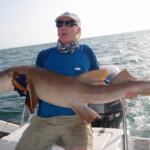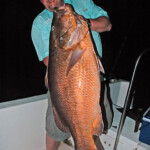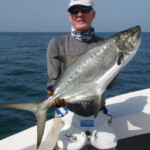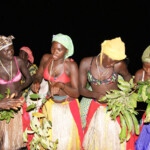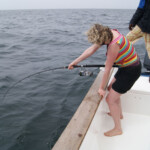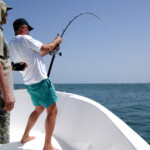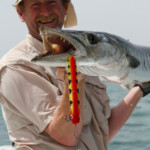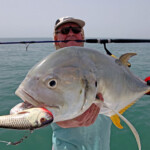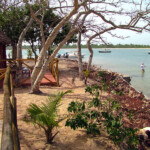Professional angling guide Richard Sheard takes a group of UK-based adventurers to Guinea-Bissau to sample the fantastic fishing on offer. With a rash of colourful species, big fish, and a monster shark encounter to write home about, they were not disappointed.
 Guinea-Bissau is a small, former Portuguese colony situated in West Africa immediately to the south of Senegal. Despite recent political unrest World Sport Fishing have been successfully running guided tours around the outer islands in the Bijagós Archipelago for a number of years. The fishing base camp is a on a small island just off the south east of the larger island of Unhocomozinho.
Guinea-Bissau is a small, former Portuguese colony situated in West Africa immediately to the south of Senegal. Despite recent political unrest World Sport Fishing have been successfully running guided tours around the outer islands in the Bijagós Archipelago for a number of years. The fishing base camp is a on a small island just off the south east of the larger island of Unhocomozinho.
The party arrived to find that wind and big tides meant coloured water from the outset, making it was almost impossible to take serious amounts of fish on the surface. Crews did however manage a rough average of six jacks per boat per day on poppers, but nothing like the normal big returns. The wrecks too produced virtually nothing to poppers or shallow runners, but the jigging and bottom fishing? Well that was an altogether different story!
The first day at a renowned jigging spot in the Uno channel – that should really read ‘spots’ as the area spans 6 km by 9 km – showed that the venue was in hot form. Clients took several jacks to 20lb and two superb snappers before Stephen Dearing hooked what was judged to be a massive grouper. The mighty fish hammered a sardine jig and towed the boat more than 1.5 km toward an exposed rock, which it circuited for a testing 55 minutes until angler and tackle were left broken and beaten in ascending order. Thereafter the shattered Shimano heavy boat jigging rod became much easier to fit in a suitcase!
Seventh Son of Seventh Sun
This was the seventh such occasion my anglers had locked horns with one of these monster fish in two seasons. The trademark fight is always the same and the negative result predictably repetitive… so far. To date these encounters have been very one-sided in favour of the fish. An incredibly powerful but slow moving fish, they do not like the light, seemingly returning to one specific spot and swimming around quite oblivious to the fact that they are connected to a frantic angler.
The running total thus far reads: seven times hooked; fought without gain for a total of 11 hours; four broken rods, and to date we haven’t had the good fortune to get one of these brutes to the surface, so a certain mystery remains. On three occasions the hook has simply pulled out after over an hour long arm-aching struggle. There are no bite-offs or teeth marks on the lure, which discounts any shark theories. And I have fought enough sharks to know the difference. There is always next time, and sooner or later we will identify and land a culprit. The rest of the first day produced a whole bunch of barracuda to 10kgs, and a more notable one of 14kgs. Trolling also dragged up a decent snapper and a pair jacks.
We ventured out to the West wreck on the second day, which lies 43 km out. A huge vessel broken into three distinct parts, it’s a place renowned for big fish. I have found the most productive methods to be trolling poppers and live bait fishing for jacks, snappers, cobia and anything else that happens along.


On arrival, poppers were cast first, and tempted nothing except for one big strike that soaked me as the fish struck and missed close to the boat. Live baiting with yaboys, a herring like baitfish, is an absolute killer method for the resident snappers. Generally speaking, as fast as get baits close to the bottom something rips them off. This is the domain of many big snappers and the fishing habitat resembles that of an underwater scrap yard. If you don’t drop down into the heart of the wreckage there will be plenty of adversaries to drag you there.

The hit and crash dive of a big snapper is difficult to describe and has to be experienced to be properly understood. Normally the first inkling is a thunderous wham that kills the bait… and this first hit is where many people go wrong and lose the fish. The instinctive, almost reflex response is to strike – DON’T! The skippers and I will always try to quell this urge and sometimes we even succeed in getting the “give him time” message over!
Softly, Softly
 The bait kill is followed by a series of almost imperceptibly slow pulls, as the fish inches the now dead bait towards his home. Because they are so slow and tentative it’s difficult to accept that this could possibly be 20kg snapper, and a normal reaction might be to dismiss the gentle interest. Lifting the lead at this point commonly ensures that it shifts into snags, leading to five minutes trying to free the jammed tackle, an eventual break-off, and a stomp up front to re-rig and start again. Patience is required to let the bite develop after the initial hit.
The bait kill is followed by a series of almost imperceptibly slow pulls, as the fish inches the now dead bait towards his home. Because they are so slow and tentative it’s difficult to accept that this could possibly be 20kg snapper, and a normal reaction might be to dismiss the gentle interest. Lifting the lead at this point commonly ensures that it shifts into snags, leading to five minutes trying to free the jammed tackle, an eventual break-off, and a stomp up front to re-rig and start again. Patience is required to let the bite develop after the initial hit.
Another regular scenario is that your particular snapper is not alone and is joined by another, at which point he feels his meal is under threat. The tentative tugging then morphs into a smash-and-grab run of the kind seldom felt from any fish, save perhaps an angry 100kg tarpon… and we get our share of those too.
If the rod is set in the rest then it’s all over before it’s begun if the fish is over 20lb. By the time you have managed to fight the rod free from the holder, he will be locked fast in his hideaway, munching on your bait with your hook hung up alongside the hooks of the last twenty anglers who have been silly enough to try getting the better of him. However, if the rod is being held when the fish takes off then you have a chance of bettering one these battlers. The odds, however remain firmly with the fish as such fish can make an absolute mockery of perceived ‘heavy’ tackle. I’ve seen the disbelief, pain and uncertainty on many faces, and anglers regularly question if even the likes of a kosher 80lb Marlin outfit would be enough to stall these well-muscled foes.
In my experience a big snapper (over 15kgs) in rough ground is the hardest thing to land anywhere. Tarpon, marlin, jacks etc are all stubborn, hard fighters but they are not the bull-shouldered, thuggish devils that large snappers are.
Claire’s Cobia Calling
After feeding thirty livebaits to the assembled snapper, and with a tally of two to the boat, we skulked off to an adjacent sandbank for some less taxing fishing. As soon as we dropped down all hell broke loose. A tearing run, which fortunately didn’t reach the sanctuary of the nearby wreck, saw a large cobia cut the surface with a great thrashing splash then immediately charge off. Claire held tight to the rod unaware of the taxing fight to come. After 15 exhilarating minutes it was obvious that this was no ordinary cobia. And if skipper Max yelled the word “Big!” once, he must have spouted it a dozen times.

30 minutes in, and Claire’s cobia was within 10 metres of the boat. It stayed there resolutely stalemated for a further 10 minutes. The fish was eventually lying subdued at the boat-side but we contrived to lose it in an abortive attempt to haul it inboard as the hook hold pulled free. Nevertheless, I called it at around 50kgs, while Max said bigger. Whatever the correct weight, it was a huge cobia… certainly the biggest I’ve ever seen and it went on to win the biggest fish of the group for the week.
Later in the day the same west wreck later provided a rash of snapper action, most of which found sanctuary in the wreck. Two ended up in the fish well… food fit for a king, or queen in Claire’s case, these would later be baked in rock salt for our evening meal.
Having exhausted the contents of the live-bait, we began trolling round the wreck. We worked pair of Storm deep thunders and two Salmo whitefish fished in a spread. Nothing happened for twenty minutes. Then, at the north end of the ground, the surface erupted; ‘Chasse!” shouted Max. The word translates from French to ‘hunting’, and a huge pack of sizeable jacks were violently hitting baitfish passing across the wreck. Had we not been trolling we would normally have charged across to cast at the school as quickly as possible. Instead, we sped up slightly and turned to troll through the area.
Cheeky Dolphin
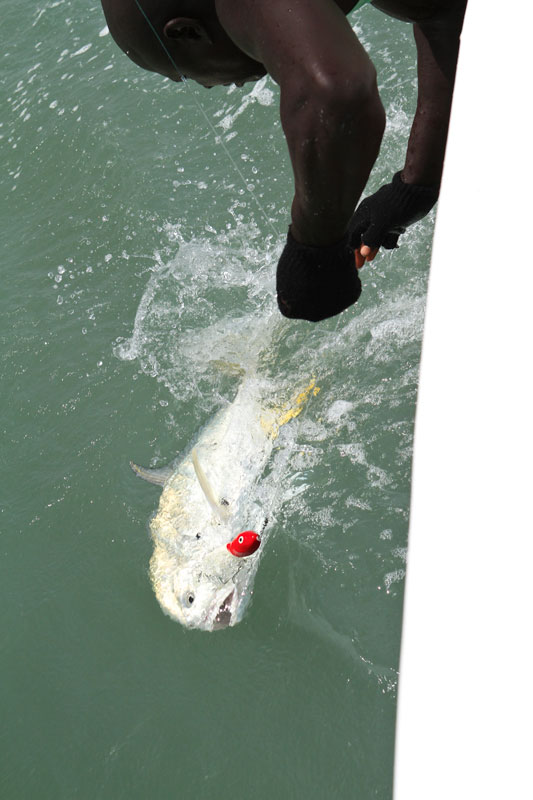 As we neared the surface disturbance a big bottle-nosed dolphin cleared 10ft of air and smashed down right into the middle of the jacks, scattering them deep and out of sight. 20 seconds later it popped up and taunted us with its catch. His mouth held a 10kg plus longfin jack, and he proceeded to swim around displaying his prize much to our chagrin.
As we neared the surface disturbance a big bottle-nosed dolphin cleared 10ft of air and smashed down right into the middle of the jacks, scattering them deep and out of sight. 20 seconds later it popped up and taunted us with its catch. His mouth held a 10kg plus longfin jack, and he proceeded to swim around displaying his prize much to our chagrin.
While all aboard were wrestling for cameras to get a shot off of flipper, one of the trolling rods went off… then immediately, a rod second bucked wildly. There followed a quick bout of knitting while we worked out which fish was going where and how fast. Dean emerged at the front of the boat, and Stephen came through at the back. Seven minutes on the watch later, Stephen had a beaten a decent jack of around 10kgs to the side of the boat. The successful bait was the fresh sushi the crew prepared for our lunch!
It quickly became apparent that whatever Dean was attached to wasn’t just another run-of-the-mill jack. The fish ran off some two hundred metres of line before gradually slowing. We approached the fish with the boat, regaining line all the way, but just as Dean began to exert more pressure on the fish from directly above it charged off again. This joined battle carried on for a full hour and three quarters.
Mystery Monster
 Max and I reckoned the as yet unseen fish to be a medium sized bull shark of maybe 250kgs. We’d caught them before on Rapalas, but using much heavier gear. This one was on a 300g jigging rod and a Daiwa Saltist multiplier, and even though it’s top gear, the chances of stopping a 500lb shark were slim. Dean is a big lad and he fought with everything at his disposal but he wasn’t winning. And the bruising encounter abruptly ended when the 80lb braid cracked off like a gunshot. Dean fell back on his haunches, a mixture of despair and relief etched upon his sweat drenched features.
Max and I reckoned the as yet unseen fish to be a medium sized bull shark of maybe 250kgs. We’d caught them before on Rapalas, but using much heavier gear. This one was on a 300g jigging rod and a Daiwa Saltist multiplier, and even though it’s top gear, the chances of stopping a 500lb shark were slim. Dean is a big lad and he fought with everything at his disposal but he wasn’t winning. And the bruising encounter abruptly ended when the 80lb braid cracked off like a gunshot. Dean fell back on his haunches, a mixture of despair and relief etched upon his sweat drenched features.
On the 40km run back in the direction of our island base, a school of Spanish mackerel were hitting bait with birds working from above. Dexter Wedges were tossed into the melee and seven-barred mackerel and Senegalese jacks were added to the species tally. For a bit of fun we have a £10 per angler sweep for biggest fish, and the same for most species which puts a competitive edge on the week.
As we approached the island, Max and I discussed the possibilities for the final hour. We had picked up few live-baits on the way back, and decided on the ‘Quarante Sept’; a huge mass of hard rock about a kilometre off the home island. I call it the ‘washing machine’ because that’s exactly what the sucking vortex looks like when the sea is running onto it.
A quick drift round the rocks casting poppers produced vaguely interested follows but no strikes. The light was fading, so we dropped anchor and prepped the bait rods. Explosive action was instant. As soon as the baits touched bottom – WALLOP! At one point all four rods were bent into fish. A ruck of cassavas and snappers were ripping at the baits as fast as we could get them down there.
In forty minutes we landed 20 – 25 decent snappers ranging from 5 to 7kg, the biggest cassavas went 13kg on the scales. In the end we simply ran out of bait. Live-baits, dead-baits… everything had been taken with relish. We returned to the island in darkness intent on the cold beers that always cap a satisfying day’s fishing.
This is just a quick taster of the fantastic fishing available out in Guinea-Bissau. I organise and guide regular extended trips out to the location, and I have just taken over the running of the fishing camp. For information on forthcoming trips or fishing advice please send an email. I look forward to talking with you. Alternatively you can browse my website.

